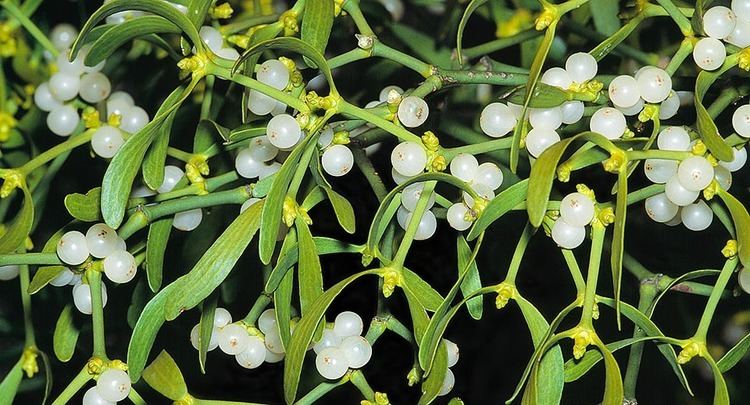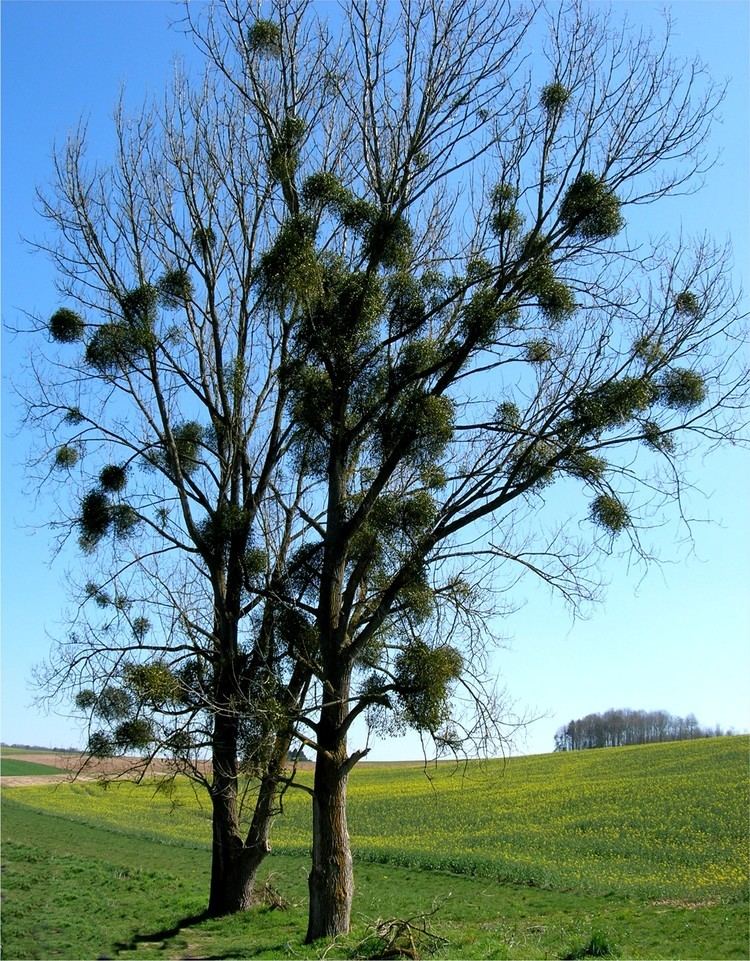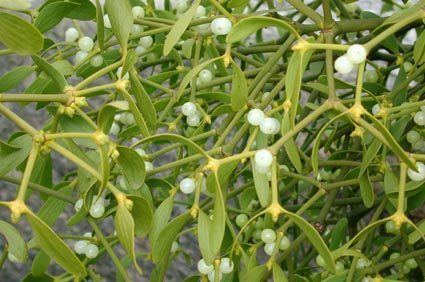Scientific name Viscum album Rank Species | ||
 | ||
Similar Common holly, Viscum, Butcher's‑broom, Yarrow, Field horsetail | ||
poisonous plants 1 2 1 viscum album mistletoe
Viscum album is a species of mistletoe in the family Santalaceae, commonly known as European mistletoe, common mistletoe or simply as mistletoe (Old English mistle). It is native to Europe and western and southern Asia.
Contents
- poisonous plants 1 2 1 viscum album mistletoe
- Mistletoe viscum album ayurvedic herb for cancer treatment
- Description
- Classification
- Subspecies
- Toxicity
- Culture folklore and mythology
- Ancient Greece and Rome
- Celtic world
- Scandinavia
- Christianity
- Local symbol
- Flavoring
- Alternative medicine
- Bird trapping
- References

Viscum album is a hemiparasite on several species of trees, from which it draws water and nutrients. It has a significant role in European mythology, legends, and customs. In modern times, it is commonly featured in Christmas decoration and symbology. (V. album is found only rarely in North America, as an introduced species; its cultural roles are usually fulfilled by the similar native species Phoradendron leucarpum.)

Mistletoe viscum album ayurvedic herb for cancer treatment
Description

It is a hemi-parasitic shrub, which grows on the stems of other trees. It has stems 30–100 centimetres (12–39 in) long with dichotomous branching. The leaves are in opposite pairs, strap-shaped, entire, leathery textured, 2–8 centimetres (0.79–3.15 in) long, 0.8–2.5 centimetres (0.31–0.98 in) broad and are a yellowish-green in colour. This species is dioecious and the insect-pollinated flowers are inconspicuous, yellowish-green, 2–3 millimetres (0.079–0.118 in) diameter. The fruit is a white or yellow berry containing one (very rarely several) seed embedded in the very sticky, glutinous fruit pulp.
It is commonly found in the crowns of broad-leaved trees, particularly apple, lime (linden), hawthorn and poplar.
Classification

The mistletoe was one of the many species originally described by Linnaeus. Its species name is the Latin adjective albus "white". It and the other members of the genus Viscum were originally classified in the mistletoe family Viscaceae, but this family has since been sunk into the larger family Santalaceae.
Subspecies

Several subspecies are commonly accepted. They differ in fruit colour, leaf shape and size, and most obviously in the host trees utilised.
Toxicity
The toxic lectin viscumin has been isolated from Viscum album. Viscumin is a cytotoxic protein (ribosome inactivating protein, or RIP) that binds to galactose residues of cell surface glycoproteins and may be internalised by endocytosis. Viscumin strongly inhibits protein synthesis by inactivating the 60 S ribosomal subunit. The structure of this protein is very similar to other RIPs, showing the most resemblance to ricin and abrin
Culture, folklore and mythology
European mistletoe has always attracted popular interest and has been surrounded by a number of myths and legends. In cultures across pre-Christian Europe, mistletoe was seen as a representation of divine male essence (and thus romance, fertility and vitality). It still plays a role in the folklore of some countries.
Ancient Greece and Rome
Mistletoe figured prominently in Greek mythology, and is believed to be the Golden Bough of Aeneas, ancestor of the Romans.
Celtic world
According to Pliny the Elder, the Celts considered it a remedy for barrenness in animals and an antidote to poison, and sacred when growing on oak trees (where it is rare). He describes a Celtic ritual sacrifice and banquet at which a druid dressed in white would climb an oak tree to collect mistletoe using a golden sickle. (This legend is often referred to in the popular Asterix comic books, where the druid Getafix is often seen collecting mistletoe with a sickle.)
Modern druids may use the Native American Phoradendron leucarpum as well as other mistletoe species.
Scandinavia
According to the 13th century Prose Edda, the goddess Frigg had all living and inanimate things swear an oath not to hurt her son Baldr. At a gathering, other gods tested the oath by hurling stones, arrows and fire at him, all in vain. But Frigg had not demanded the oath from mistletoe, because "it seemed too young" for that. By a scheming of Loki, Baldr's brother, the blind god Höðr made an arrow from mistletoe and killed Baldr with it.
In the Gesta Danorum version of the story, Baldr and Höðr are rival suitors, and Höðr kills Baldr with a sword named Mistilteinn (Old Norse "mistletoe"). In addition, a sword by the same name appears in various other Norse legends.
Christianity
When Christianity became widespread in Europe after the 3rd century AD, the religious or mystical respect for the mistletoe plant was integrated to an extent into the new religion. In some way that is not presently understood, this may have led to the widespread custom of kissing under the mistletoe plant during the Christmas season. The earliest documented case of kissing under the mistletoe dates from 16th century England, a custom that was apparently very popular at that time.
Winston Graham reports a Cornish tradition that mistletoe was originally a fine tree from which the wood of the Cross was made, but afterwards it was condemned to live on only as a parasite.
Mistletoe is commonly used as a Christmas decoration, though such use was rarely alluded to until the 18th century. According to custom, the mistletoe must not touch the ground between its cutting and its removal as the last of Christmas greens at Candlemas. It may remain hanging throughout the year, often to preserve the house from lightning or fire, until it is replaced the following Christmas Eve. The tradition has spread throughout the English-speaking world, but is largely unknown in the rest of Europe. (The similar native species Phoradendron leucarpum is used in North America in lieu of the European Viscum album.)
According to an old Christmas custom, a man and a woman who meet under a hanging of mistletoe were obliged to kiss. The custom may be of Scandinavian origin. It was alluded to as common practice in 1808 and described in 1820 by American author Washington Irving in his The Sketch Book of Geoffrey Crayon, Gent.:
The mistletoe is still hung up in farm-houses and kitchens at Christmas, and the young men have the privilege of kissing the girls under it, plucking each time a berry from the bush. When the berries are all plucked the privilege ceases.
Local symbol
Mistletoe is the County flower of Herefordshire. It was voted such in 2002 following a poll by the wild plant conservation charity Plantlife.
Flavoring
Mistletoe is an ingredient of pomace brandy based liquor biska made in Istra, Croatia.
Alternative medicine
Mistletoe leaves and young twigs are used by herbalists, and preparations made from them are popular in Europe, especially in Germany, for attempting to treat circulatory and respiratory system problems. Use of mistletoe extract in the treatment of cancer originated with Rudolf Steiner, the founder of Anthroposophy.
Although laboratory and animal experiments have suggested that mistletoe extract may affect the immune system and be able to kill some kinds of cancer cells, there is little evidence of its benefit to people with cancer.
Bird trapping
The sticky juice of mistletoe berries was used to make birdlime, an adhesive to trap small animals or birds.
